Publication to accompany The Northern Isles Exhibition. With an introduction and poem by poet, writer and Shetlander, Christine De Luca.
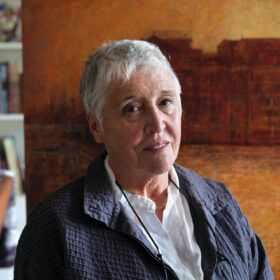
Victoria Crowe studied at Kingston School of Art from 1961-65 and at the Royal College of Art, London, from 1965-68. At her postgraduate show, she was invited by Sir Robin Philipson to teach at Edinburgh College of Art. For thirty years she worked as a part-time lecturer in the School of Drawing and Painting while developing her own artistic practice. She lives and works in West Linton and Edinburgh. Her first one-person exhibition, after leaving the Royal College of Art, was in London and has subsequently held over fifty, one person shows.
Victoria Crowe’s first solo exhibition at The Scottish Gallery was in 1970. In August 2018, The Gallery held a major exhibition of paintings to coincide with The Scottish National Portrait Gallery’s retrospective of Victoria Crowe’s portraits. In 2019 The City Art Centre held a retrospective entitled 50 Years of Painting. This exhibition embraced every aspect of Crowe’s practice and featured over 150 paintings, works on paper and sketchbooks and several films of the artist were commissioned.
Victoria Crowe is a member of the Royal Scottish Academy (RSA) and the Royal Scottish Society of Painters in Watercolours (RSW). Crowe has exhibited nationally and internationally and undertaken many important portrait commissions, including HRH The King, RD Laing, Peter Higgs and Jocelyn Bell Burnell. Crowe’s work is held in numerous public and private collections worldwide.
In 2000, Crowe’s exhibition A Shepherd’s Life, consisting of work selected from the 1970s and 80s, was curated for the National Galleries of Scotland’s to mark the Millennium. The exhibition toured Scotland and was re-gathered in 2009 for the Fleming Collection, London.
Crowe was awarded an OBE for Services to Art in 2004 and from 2004-2007, she was appointed Senior Visiting Scholar at St. Catherine’s College, Cambridge. The resulting work, Plant Memory, was exhibited at the Royal Scottish Academy in 2007 and subsequently toured Scotland. In 2009 she received an Honorary Degree from The University of Aberdeen and in 2010 was elected a Fellow of the Royal Society of Edinburgh.
In 2013, Dovecot Studios wove a large-scale tapestry of Crowe’s painting Large Tree Group. This collaborative tapestry was acquired for the National Museums Scotland. In 2015, Crowe invited as artist-in-residence at Dumfries House and in 2016 a group of work from the residency was acquired by the National Galleries of Scotland. Crowe was commissioned by the Worshipful Company of Leathersellers’ in 2014, to design a forty-metre tapestry for their new hall in the city of London, which took over three years to weave and was installed in January 2017. Dovecot worked with Victoria Crowe to produce a new tapestry inspired by a detail from her painting Twilight, Venice, 2014. The new tapestry, Richer Twilight, Venice was completed and unveiled at the end of September 2019.
Following a residency in Orkney in 2022, the Pier Art Centre in Stromness held a major exhibition of new work, Touching the Surface from August to November 2024, in which she looked specifically at the contrasting light around the summer and winter solstices.
The Scottish Gallery exhibitions: 1970, 1973, 1977, 1982, 1995, 1998, 2001 (Festival), 2004, 2006, 2008, 2010 (Festival), 2012, 2014 (Festival), 2016, 2018 (Festival), 2019, 2021, 2023, 2025 (Festival, 80th)

Wilhelmina Barns-Graham (1912–2004) was a leading member of the St Ives group of artists and made an outstanding contribution to the advancement of post-war British art. Last year, filmmaker and director Mark Cousins directed a new film A Sudden Glimpse to Deeper Things, which is a cinematic immersion into Wilhelmina Barns-Graham’s art and life. The film will be on general release in 2025. Wilhelmina Barns-Graham, known as Willie, was born in St Andrews, Fife, on 8 June 1912. Determining while at school that she wanted to be an artist, she set her sights on Edinburgh College of Art, where she enrolled in 1932 and graduated with her diploma in 1937. At the suggestion of the College’s principal, Hubert Wellington, she moved to St Ives in 1940. Early on she met Borlase Smart, Alfred Wallis and Bernard Leach, as well as Ben Nicholson, Barbara Hepworth and Naum Gabo who were living locally at Carbis Bay. Her peers in St Ives include, among others, Patrick Heron, Terry Frost, Roger Hilton, and John Wells. Barns-Graham’s history is bound up with St Ives, where she lived throughout her life. In 1951 she won the Painting Prize in the Penwith Society of Arts in Cornwall Festival of Britain Exhibition and went on to have her first London solo exhibition at the Redfern Gallery in 1952. She was included in many of the important exhibitions on pioneering British abstract art that took place in the 1950s. In 1960, Barns-Graham inherited Balmungo House near St Andrews, which initiated a new phase in her life. From this moment she divided her time between the two coastal communities, establishing herself as a Scottish artist as much as a St Ives one. Wilhelmina Barns-Graham was represented by The Scottish Gallery throughout her career. Important exhibitions of her work at the Tate St Ives in 1999/2000 and 2005, and the publication of the first monograph on her life and work, Lynne Green’s W. Barns-Graham: A Studio Life, 2001, confirmed her as one of the key contributors of the St Ives School, and as a significant British modernist. She died in St Andrews on 26 January 2004.
The Scottish Gallery exhibitions: 1956, 1960, 1981 (Festival), 1989 (London), 2016, 2019, 2022

Wilhelmina Barns-Graham (1912–2004) was a leading member of the St Ives group of artists and made an outstanding contribution to the advancement of post-war British art. Last year, filmmaker and director Mark Cousins directed a new film A Sudden Glimpse to Deeper Things, which is a cinematic immersion into Wilhelmina Barns-Graham’s art and life. The film will be on general release in 2025. Wilhelmina Barns-Graham, known as Willie, was born in St Andrews, Fife, on 8 June 1912. Determining while at school that she wanted to be an artist, she set her sights on Edinburgh College of Art, where she enrolled in 1932 and graduated with her diploma in 1937. At the suggestion of the College’s principal, Hubert Wellington, she moved to St Ives in 1940. Early on she met Borlase Smart, Alfred Wallis and Bernard Leach, as well as Ben Nicholson, Barbara Hepworth and Naum Gabo who were living locally at Carbis Bay. Her peers in St Ives include, among others, Patrick Heron, Terry Frost, Roger Hilton, and John Wells. Barns-Graham’s history is bound up with St Ives, where she lived throughout her life. In 1951 she won the Painting Prize in the Penwith Society of Arts in Cornwall Festival of Britain Exhibition and went on to have her first London solo exhibition at the Redfern Gallery in 1952. She was included in many of the important exhibitions on pioneering British abstract art that took place in the 1950s. In 1960, Barns-Graham inherited Balmungo House near St Andrews, which initiated a new phase in her life. From this moment she divided her time between the two coastal communities, establishing herself as a Scottish artist as much as a St Ives one. Wilhelmina Barns-Graham was represented by The Scottish Gallery throughout her career. Important exhibitions of her work at the Tate St Ives in 1999/2000 and 2005, and the publication of the first monograph on her life and work, Lynne Green’s W. Barns-Graham: A Studio Life, 2001, confirmed her as one of the key contributors of the St Ives School, and as a significant British modernist. She died in St Andrews on 26 January 2004.
The Scottish Gallery exhibitions: 1956, 1960, 1981 (Festival), 1989 (London), 2016, 2019, 2022

Sylvia Hays studied art at Northwestern University, Chicago before commencing teaching art and history of art at the Mary Baldwin University in Virginia. She moved to the UK in 1974 to continue her art practice and moved to Orkney in 2002. Sylvia’s first solo exhibition in Orkney, A Place in the Land, was held at the Pier Art Centre, and toured nationally. Sylvia has exhibited internationally with her most recent exhibition being held at the Orkney Museum.
‘Living in Orkney, to borrow a phrase, ‘concentrates the mind wonderfully.’ Certainly, the austere landscape, the ever-present sea with its pageantry of weather-induced moods and colours, concentrates the senses. Sylvia Hays, the American painter who has known Orkney for twenty- five years, and has lived here since 2002, has an independent mind and would not willingly surrender a particle of her liberty. Orkney to her was freedom. A place ‘out of the box’ of the southern art world. Sylvia Hays employs all the resources of a modern painter to depict her own environment, she gave them a depth of feeling, a richness of colour and texture, a personal drama, beyond the grasp of a traditionally trained landscape or marine painter. There is a constant presence of a horizon, that great horizontal that all painters must keep in their minds even when they conceal it.’ – Douglas Hall, 2011 (Founder and first Keeper of the Scottish National Gallery of Modern Art, Edinburgh)
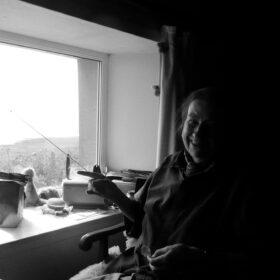
Wishart was an Orkadian who had always painted. She was encouraged by artist and poet friends to attend Gray’s School of Art as a mature student. She then taught in Aberdeenshire, Lewis and Orkney before taking a position at Gray’s and moving to a cottage on Ythan Estuary at Howe near Tarty. It is with Orkney that she is most associated and most of her work is still on the islands. She had a studio initially on the pier at Stromness, which became the Pier Art Centre to house the collection of her great friend Margaret Gardiner. After a major refurbishment, the gallery reopened with a Wishart exhibition in 2007. Her home was at Heatherybraes looking over Hoy Sound and St John’s Head: a vista of fields, shores and distant cliffs which was her favourite subject.
We are currently looking for work by Sylvia Wishart, if you have any works you are interested in selling please contact The Gallery.

Alex Boyd is a landscape and documentary photographer, printmaker and writer. His work is concerned with landscape, identity and land ownership, themes he has explored with collaborators such as Edwin Morgan and musician Nick Cave. His work examines the role of early Scottish landscape photographers, often using antique processes such as the Victorian ‘wet-plate collodion’ process using plate cameras on mountain tops. His series on the Cuillin mountains on the Isle of Skye during his RSA’s Residency in 2013 is held in several national collections including the National Galleries of Scotland; Royal Scottish Academy, Edinburgh; Victoria & Albert Museum, London and The Yale Center for British Art, USA.
‘Alex Boyd’s images represent a major addition to the tradition of modern landscape photography.’ – Robert Macfarlane, Author
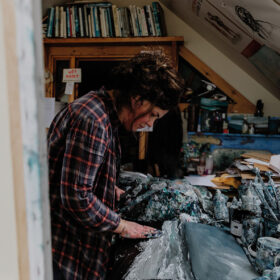
Born near Edinburgh in 1972, Ruth Brownlee graduated from Edinburgh College of Art in 1994. In 1998, she moved to Shetland. Her work is included in the public collections of The Fleming-Wyfold Collection, London, and Shetland Museum.
‘Having lived by the sea since visiting Shetland to teach a painting workshop 24 years ago, my work continues to be inspired by this archipelago in the North Sea. Shetland is a rugged environment with an intense visual drama of constant changing elements. As I love walking and walk whenever I can; I watch the weather, and read the mood of the sea which filters into my studio practice. Capturing the intense atmosphere of this wild place is more important to me than trying to include the details of the coastal landscape.’ – Ruth Brownlee

I paint Orkney outside. The wind and dynamic light are energies which make me happy; they fly by while the mass is going nowhere. Diana Leslie
After graduating from Glasgow School of Art in 1998, Diana Leslie returned to her home in Orkney to set up her studio in Stromness. It is her deep sense of belonging that allows Leslie to create intimate and honest depictions of the Orcadian townscape and community. Her sources are various; Stromness, the sea, flowers, art. She works with paint, print and drawing. Landscape is central to her practice.
‘Painting has a magical property: it can hold on to energy and strange things like freedom, even when the artist is long gone. It tells its own truth.’ Diana Leslie
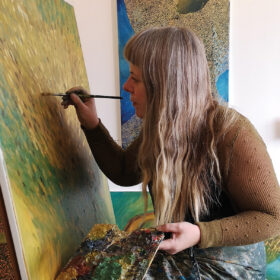
Laura Drever was born in Kirkwall, Orkney. Laura studied Drawing and Painting at Edinburgh College of Art and works from her studio in Kirkwall. For nearly twenty years Laura has been exploring the changing nature of her native islands. By walking over and through the landscape the artist has come to a deep understanding of the fabric and form of the hills, valleys and seascapes around her. She has exhibited regularly throughout the UK, and takes an active role in Orkney’s creative community. Laura is Chair of Soulisquoy Printmakers, delivers creative workshops and nurtures others through short residencies with locally based arts organisations.
‘The modern Orkney landscape is characterised by the agricultural developments of the last 150 years or so, which saw a complete transformation in appearance from common grazing and piecemeal cultivation, to squared-off, drained and ordered fields. The higher up and more difficult to reach places, that proved impossible to put under the plough, endured, and most outlooks across the islands are capped by a contrasting layer of rough grass and heather. It is to these more rugged and untamed landscapes that Laura Drever is most often attracted… [and her paintings] offer a sense of the geology of these unpeopled landscapes and, through the artist’s careful modulation of tone and colour, a feeling of slowly evolving space.’ – Extract from Teebro, New Work by Laura Drever, Andrew Parkinson, The Pier Arts Centre, 2022

Born, raised and educated in Orkney, Kevin has been working with wood ever since childhood. Growing up, he could always be found in the family garden shed making wooden items. His hobby developed into his passion when he left school in 1996 at the age of 16 to launch his much-desired career as an apprentice with a well-known local furniture maker who held a reputation for high-quality craftsmanship. Here, he continued to work and expand his skills and techniques for nine years, which eventually lead to him establishing himself as The Orkney Furniture Maker in April of 2007 with the aim of producing traditional furniture as well as his own new designs.
Kevin’s work brings together his passion for local traditional techniques and materials, combining them with innovation and design to create unique pieces with a connection to his island home. Every piece from the collection is individually created by him and his small, dedicated team. Kevin has exhibited locally, nationally and internationally and now has a world-wide customer base.

Kenneth Gray is an Edinburgh based freelance graphic designer and photographer. Kenneth has worked on a wide variety of commissions, including arts catalogues, brochures, corporate identities, prospectuses, children’s magazines and websites. Earlier this year Kenneth Gray was commissioned by the artist Victoria Crowe to visit Orkney and document her RSA residency there. This was a great opportunity to record Victoria’s work, her response to the expansive rock and seascapes, and for him to react personally to Orkney’s ancient environment through photography. Kenneth’s photographic portrait of Victoria Crowe is held in the collection of the Scottish National Portrait Gallery.
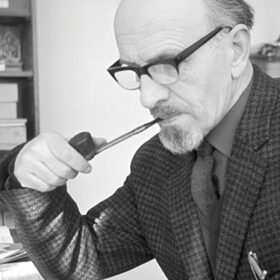
Ian Fleming was born in Glasgow in 1906 and studied at Glasgow School of Art during the 1920s. He began printmaking at art school, where his skill was quickly noticed, with Glasgow Art Gallery purchasing two of his prints while he was still a student. He joined the staff at Glasgow School of Art in 1931 and soon met the Edinburgh-based printmaker William Wilson through their mutual acquaintance Adam Bruce Thomson. Wilson and Fleming struck up an important friendship, sharing views on printmaking technique and subjects, their influence on each other was of mutual benefit to both their practices. During his time at Glasgow School of Art Fleming painted a portrait of the two Roberts – Colquhoun and Macbryde – who were his students at the time (alongside a young Joan Eardley). During the War, Fleming served first as a reserve policeman before joining the Pioneer Corps seeing action in France, the Low Countries and Germany. He left the Army in 1946 as an Acting Major and returned briefly to Glasgow before taking up the position of Warden at Hospitalfield, Arbroath, succeeding the artist, James Cowie. The fishing towns of Angus and Kincardineshire were to be his inspiration for many paintings of this period in which he celebrated the colour, forms and architecture of the working harbour communities. In 1954, he relocated to Aberdeen as Principal of Gray’s School of Art but continued to pursue his painting practice alongside his academic commitments. He was elected a full Academician of the Royal Scottish Academy in 1956, and by the time of his death was the longest-established member. After retiring in 1971, he became one of the founding members of Peacock Printmakers in Aberdeen, alongside Frances Walker.
The Scottish Gallery exhibitions: 1947, 1987

Anne Campbell has worked as an artist and photographer for over twenty years, living and working in the Northeast of Scotland, where she has a studio in the village of Monymusk. She currently teaches photography at Gray’s School of Art in Aberdeen. Anne specialises in traditional and experimental darkroom processes to explore the Scottish landscape and capture the fragile northern ecosystems of the Highlands and Islands. Working with film and chemical processes, (layering and exposing different areas of the print by the use of bleaching and redeveloping), allows for the creation of textural layers, creating one- off, subtle yet complex images, that mirror the atmospheric and changeable weather systems, the landscape and her response to it; the transitory nature of human presence. The surface qualities can be painterly and descriptive of personal experience or may mirror the visceral qualities of nature: they can reference the past while looking to the future.

Pat Douthwaite was born in Glasgow in 1934. She studied mime and modern dance with Margaret Morris, whose husband, J. D. Fergusson, encouraged her to paint. This important influence apart, she was self-taught. In 1958 Pat lived in Suffolk with a group of painters, including the Scots Colquhoun and MacBryde, and William Crozier. From 1959-1988 she travelled widely, to N. Africa, India, Peru, Venezuela, Europe, U.S.A., Kashmir, Nepal, Pakistan, Ecuador and from 1969 lived part of the time in Majorca, and more recently in various properties across the Scottish Borders. She died in July 2002 in Broughty Ferry.
Douthwaite seems to find it necessary, like a method actress, to inhabit the idea, to get inside the skin of the role, as it were. Her paintings, often grotesque for all their elegance, can range in mood from tragicomic frenzy to angst-ridden melancholy, but they usually have a certain exciting theatricality in common. Cordelia Oliver, 1981
Gallery Director Guy Peploe knew the artist well and is the recognised expert on her work. He published a monograph on the artist in 2016.
The Scottish Gallery exhibitions: 1977, 1993, 1995, 1998, 2000 (Retrospective), 2005 (Memorial), 2011 (Retrospective – Paintings & Works on Paper), 2014, 2016, 2020 (London), 2021

Born in North Carolina, Kate Downie studied at Grays School of Art in Aberdeen before travel and residencies took her to the United States, England, Amsterdam and Paris. Over the past two decades Downie has established herself as one of Scotland’s most prominent artists. Her skill not restricted to painting alone, she works across a diverse range of artistic medium. One recent project for Pittenweem Arts Festival saw Kate juxtapose large colour-field prints with architectural charcoal drawings with extraordinary results. The majority of her work is defined by geography, and the artist’s response to the landscape or subject in front of her. Kate’s constant search for new challenges and inspirations has seen her set up studios in such diverse places as a brewery, an oil rig, and for her most recent show an abandoned Hydroponicum. Her work is held in many public collections including Glasgow Gallery of Modern Art; Kelvingrove, Art Gallery: Reitveld Kunst Academie, Amsterdam; the BBC and Edinburgh Council. Downie has enjoyed ten solo exhibitions at The Scottish Gallery. She is currently exhibiting at the Glasgow Women’s Library with Conversations with Joan. An exhibition based around Downie’s creative journey to complete a version of Joan Eardley’s painting Two Children left unfinished on her Townhead Studio easel at the time of her death in 1963.
‘One of my creative concerns is to define these spaces between buildings rather than the buildings themselves. The object lesson for me is the witnessing and the drawing of these nonplaces which are also, by definition, public arenas of cumulative activity. My job as an artist is to accommodate these actions in our contemporary lives, and to find the poetry within.’
– Kate Downie

Born in Greenock, Ron Sandford studied at Glasgow School of Art in the late 1950s before continuing at the Royal College of Art, London, specialising in graphics. Renowned for his highly detailed architectural drawings, he worked with leading architects, including Norman Foster, on major commissions such as the Broadgate Centre and Thames Millennium Bridge. His career later took him to Hong Kong before he settled in Yell, Shetland, in 2002 with his wife, illustrator Meilo So. There, he immersed himself in documenting the landscape, people, and maritime traditions.

Frances Scott is a photographic artist from Orkney, currently based in Glasgow. She studied Communication Design at Glasgow School of Art, specialising in photography and graduating in 2014. Her work examines themes of memory, geography, and belonging, often centred around journeys made through landscapes of personal significance. Since 2016 Frances has been working on a long–term project to walk and document the coastlines of Orkney. She is a founding member of the Orkney–based Móti Collective, and a co-creator of Holm Sound, a digital offshoot of ØY Festival.

Born in Kirkcaldy in 1930 Frances Walker studied at Edinburgh College of Art and then took up a post as visiting teacher of art for the Hebrides. This experience engendered in her a life-long love of wild and desolate places and since then she has chosen to depict the most remote landscapes, her compositions usually based on coastal reaches, craggy rocks and deserted beaches. Moving to Aberdeen, Walker took up a post at Gray’s School of Artwhere she taught for many years. After retirement she has since divided her time between Aberdeen and the Western Isles, especially Tiree, where she owns a thatched cottage, but more recently has also travelled further afield – her latest inspiration being the even wilder and more desolate landscape of the Antarctic and South Georgia. A suite of Antarctic paintings were recently bequeathed and exhibited as part of a major exhibition, Among the Polar Ice at The McManus in Dundee (September 2019 – March 2020).
Click here to see prints by the artist.